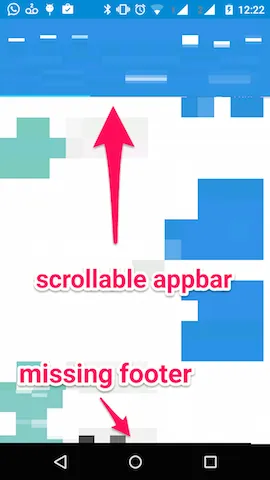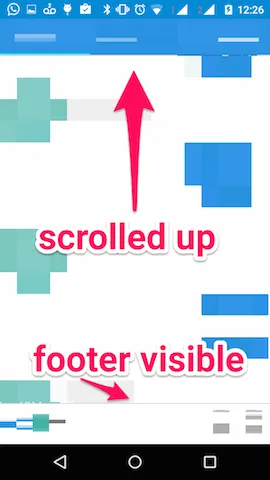package pl.mkaras.utils;
import android.content.Context;
import android.support.design.widget.AppBarLayout;
import android.support.design.widget.CoordinatorLayout;
import android.support.v4.view.ViewCompat;
import android.support.v7.widget.Toolbar;
import android.util.AttributeSet;
import android.view.View;
import android.view.ViewGroup;
import java.util.List;
public class ScrollViewBehaviorFix extends AppBarLayout.ScrollingViewBehavior {
public ScrollViewBehaviorFix() {
super();
}
public ScrollViewBehaviorFix(Context context, AttributeSet attrs) {
super(context, attrs);
}
public boolean onMeasureChild(CoordinatorLayout parent, View child, int parentWidthMeasureSpec, int widthUsed, int parentHeightMeasureSpec,
int heightUsed) {
if (child.getLayoutParams().height == -1) {
List<View> dependencies = parent.getDependencies(child);
if (dependencies.isEmpty()) {
return false;
}
final AppBarLayout appBar = findFirstAppBarLayout(dependencies);
if (appBar != null && ViewCompat.isLaidOut(appBar)) {
int availableHeight = View.MeasureSpec.getSize(parentHeightMeasureSpec);
if (availableHeight == 0) {
availableHeight = parent.getHeight();
}
final int height = availableHeight - appBar.getMeasuredHeight();
int heightMeasureSpec = View.MeasureSpec.makeMeasureSpec(height, View.MeasureSpec.AT_MOST);
parent.onMeasureChild(child, parentWidthMeasureSpec, widthUsed, heightMeasureSpec, heightUsed);
int childContentHeight = getContentHeight(child);
if (childContentHeight <= height) {
updateToolbar(parent, appBar, parentWidthMeasureSpec, widthUsed, parentHeightMeasureSpec, heightUsed, false);
heightMeasureSpec = View.MeasureSpec.makeMeasureSpec(height, View.MeasureSpec.EXACTLY);
parent.onMeasureChild(child, parentWidthMeasureSpec, widthUsed, heightMeasureSpec, heightUsed);
return true;
} else {
updateToolbar(parent, appBar, parentWidthMeasureSpec, widthUsed, parentHeightMeasureSpec, heightUsed, true);
return super.onMeasureChild(parent, child, parentWidthMeasureSpec, widthUsed, parentHeightMeasureSpec, heightUsed);
}
}
}
return false;
}
private static int getContentHeight(View view) {
if (view instanceof ViewGroup) {
ViewGroup viewGroup = (ViewGroup) view;
int contentHeight = 0;
for (int index = 0; index < viewGroup.getChildCount(); ++index) {
View child = viewGroup.getChildAt(index);
contentHeight += child.getMeasuredHeight();
}
return contentHeight;
} else {
return view.getMeasuredHeight();
}
}
private static AppBarLayout findFirstAppBarLayout(List<View> views) {
int i = 0;
for (int z = views.size(); i < z; ++i) {
View view = views.get(i);
if (view instanceof AppBarLayout) {
return (AppBarLayout) view;
}
}
throw new IllegalArgumentException("Missing AppBarLayout in CoordinatorLayout dependencies");
}
private void updateToolbar(CoordinatorLayout parent, AppBarLayout appBar, int parentWidthMeasureSpec, int widthUsed, int parentHeightMeasureSpec,
int heightUsed, boolean toggle) {
toggleToolbarScroll(appBar, toggle);
appBar.forceLayout();
parent.onMeasureChild(appBar, parentWidthMeasureSpec, widthUsed, parentHeightMeasureSpec, heightUsed);
}
private void toggleToolbarScroll(AppBarLayout appBar, boolean toggle) {
for (int index = 0; index < appBar.getChildCount(); ++index) {
View child = appBar.getChildAt(index);
if (child instanceof Toolbar) {
Toolbar toolbar = (Toolbar) child;
AppBarLayout.LayoutParams params = (AppBarLayout.LayoutParams) toolbar.getLayoutParams();
int scrollFlags = params.getScrollFlags();
if (toggle) {
scrollFlags |= AppBarLayout.LayoutParams.SCROLL_FLAG_SCROLL;
} else {
scrollFlags &= ~AppBarLayout.LayoutParams.SCROLL_FLAG_SCROLL;
}
params.setScrollFlags(scrollFlags);
}
}
}
}
这种行为基本上是从
AppBarLayout中删除滚动标志
SCROLL,当依赖视图(
RecyclerView、
NestedScrollView)中的滚动内容小于视图高度时,即不需要滚动时。它还覆盖了通常由
AppBarLayout.ScrollingViewBehavior完成的偏移滚动视图的操作。在向滚动视图添加页脚(如按钮)或在
ViewPager中使用时效果很好,因为每个页面的内容长度可能不同。

